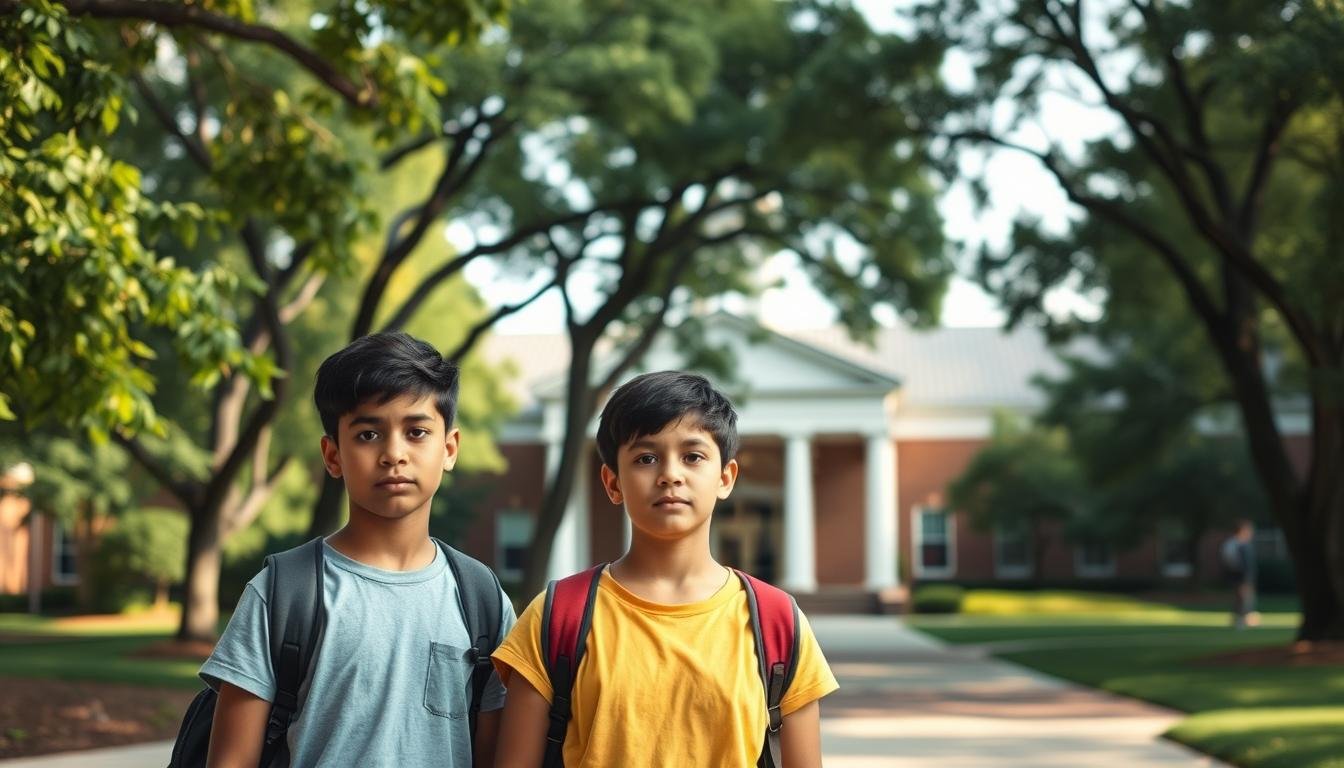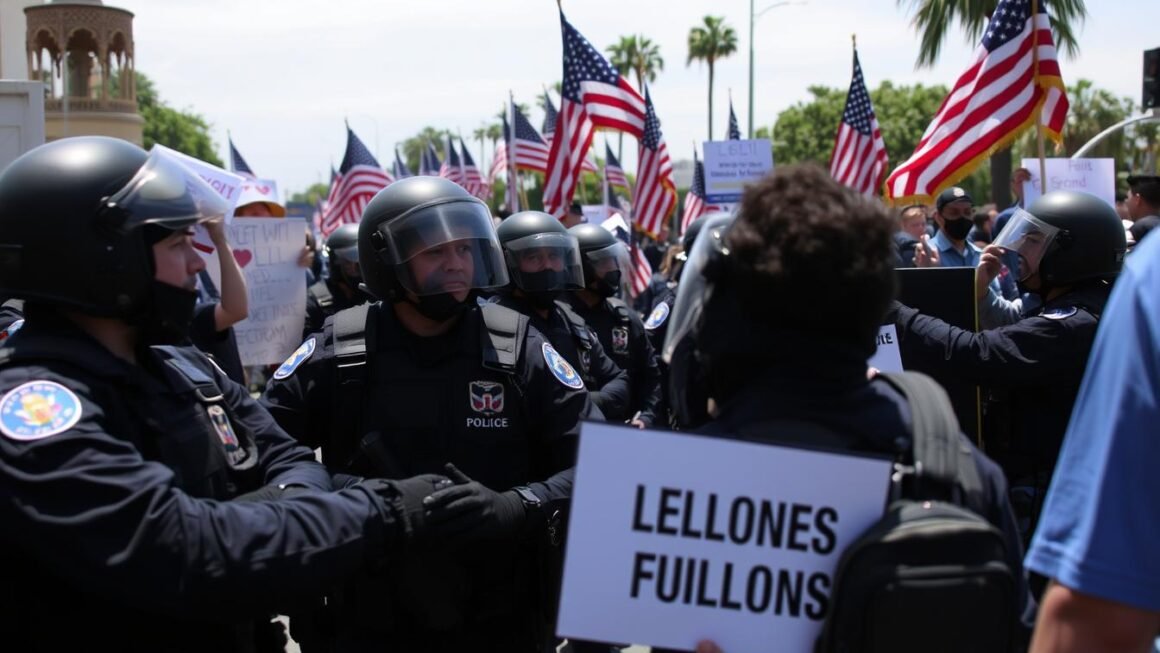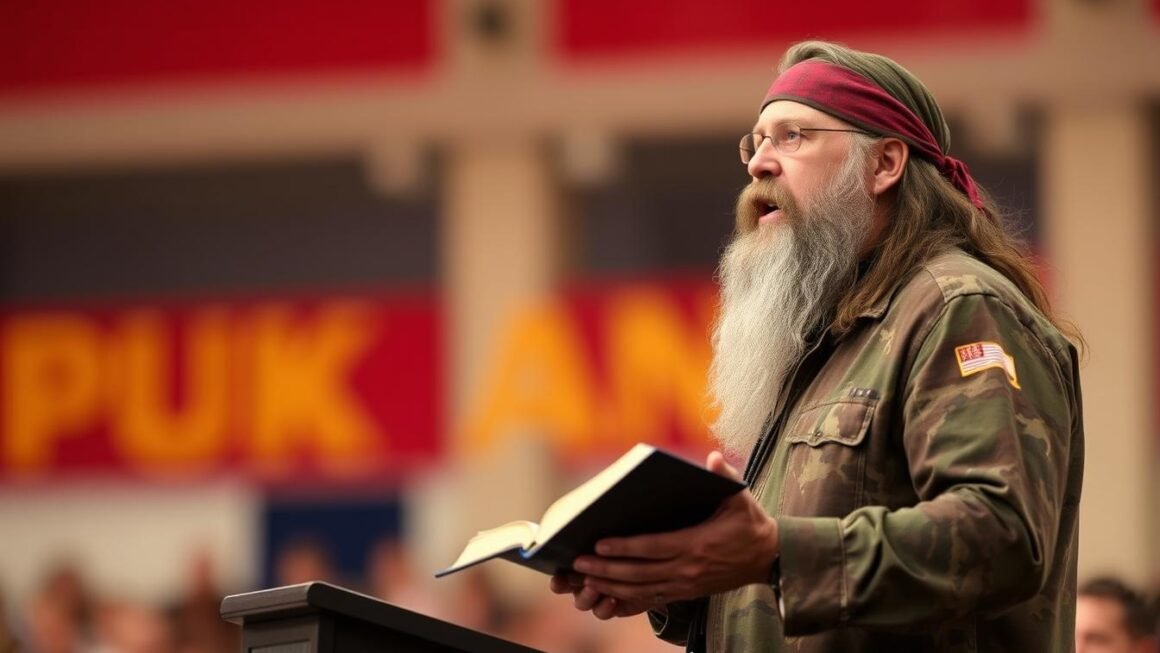Imagine a typical day at Stone Bridge High School. Lockers line the halls, buzzing with teen talk and the smell of cafeteria pizza. But then, something big happens. Three male students get into hot water. Why? A peer, identifying as male but born female, filmed them in the locker room. This sure is a sticky situation.
This incident got people talking about privacy, student rights, and school rules. What happened has everyone from students to the community asking big questions. How do schools deal with such tricky issues? Let’s dive into the privacy and justice debate at Loudoun County Schools.
Key Takeaways
- The incident at Stone Bridge High School raises important questions about privacy and justice.
- Legal rights of students are under scrutiny in the context of school policies.
- Data protection is a key consideration in handling sensitive situations.
- Community engagement is vital to address concerns surrounding these incidents.
- The need for clear guidelines in schools regarding gender identity and privacy is paramount.
Introduction to the Loudoun County Incident
Imagine being in Stone Bridge High School’s gym. You’re surrounded by normal sounds of a gym class. But then, something unexpected happens, shaking up more than just the locker room. It involves three boys, a Title IX investigation, and a female student who identifies as male entering their space during class.
Before you know it, the situation escalates. News outlets like 7News highlighted the growing tension in the locker room. The boys were upset about being recorded, leading to harassment claims against them. The investigation looked into their actions, while the female student’s actions were almost ignored.
This event has sparked a big debate on privacy and safety. Many are questioning if the high school handled things fairly. It highlights ongoing debates about student rights and safety. Loudoun County’s story shows us why we need to pay attention to these issues.
Understanding the Context of Privacy and Justice
When talking about student rights, privacy is key. Today, schools work hard to keep students safe while respecting their privacy. This balance becomes even trickier after events in Loudoun County.
Gender identity debates put these issues in the spotlight. Schools strive to protect student identities but must also respect privacy. It’s like playing Twister – one wrong move can lead to a big mess over students’ rights and society’s expectations.
Consider Title IX, aimed at stopping discrimination and ensuring equal education. It supports student rights but sometimes conflicts with privacy concerns. Schools face the challenge of protecting some students’ privacy while letting others express themselves. It’s a delicate balance with high stakes.
We must talk openly about privacy’s possible negative effects. Misunderstandings from these discussions can lead to conflicts. As the debate continues in Loudoun County and elsewhere, educators, parents, and peers play a key role. They help build understanding and empathy around student rights. Everyone deserves a respectful and private learning environment.
| Aspect | Description |
|---|---|
| Privacy Rights | Refers to individual rights in educational settings, pertaining to personal information and identity. |
| Justice in Education | Focuses on fair treatment and equal opportunities for all students, without discrimination. |
| Student Rights | Legal entitlements that include safety, privacy, and access to education without bias. |
The Role of Loudoun County Public Schools (LCPS) in Student Safety
Thinking about LCPS role in student safety sheds light on more than just stopping bullies. We look into various educational policies that shape how students experience their day-to-day life at school. The hard part? It’s figuring out how to respect students’ rights while also addressing privacy issues. It almost feels like a twist right out of a teen drama show.
The introduction of Policy 8040 has sparked lots of discussions around gender identity and access to certain facilities. This policy is meant to let students be themselves, promoting a sense of belonging. But it hasn’t been smooth sailing — imagine trying to make a soufflé but missing key ingredients. Some students worry about their privacy in places like locker rooms, leading to uneasy feelings.
Schools should be safe places, but achieving this is complex because LCPS role touches on more than just physical safety. Emotional well-being is just as important. These education policies bring up heated debates. To make progress, we need clear communication and open discussions. Everyone should feel like their voice matters, even if they just want less awkward moments in changing areas.
The Title IX Investigation Explained
A Title IX investigation involves three male students and is key in debates on student behavior and privacy. The situation got complicated as the boys’ first responses led to serious sexism charges. What began with privacy worries soon turned into examining their deeds and experiences.
This probe seeks to keep up school norms while balancing student safety and privacy. The boys shared their unease, sparking debates about the process’s fairness. Supporters on both sides voice their views strongly, fueling discussions.
In the end, the Title IX inquiry shows the tough act schools face. They must guard everyone’s rights yet seriously address complaints. This balance is hard for schools to achieve.
Privacy Concerns in School Settings
Privacy issues in schools are getting complicated. You might know about times when students recorded others in locker rooms. This really makes us think about student rights. Nowadays, with everyone sharing everything online, keeping private things private at school is very hard.
It’s tough to keep everyone safe while respecting their rights. Schools often don’t make clear rules, leaving everyone unsure. When we add in topics like gender identity, it gets even more complex. For example, a girl recording in a locker room can upset many, raising big questions about safety and privacy.
Students often ask, “What are my rights?” or “What if someone invades my privacy?” It’s important to see student rights as more than just words in meetings. They are key to making schools safe. Having clear rules about privacy and recording can help everyone feel respected and safe.
Talking openly about privacy is crucial in our tech-filled world. Students deserve to feel safe without worrying about privacy issues. They should enjoy a place that is inclusive and respects everyone.
Legal and Ethical Guidelines for Student Conduct
Dealing with student behavior requires understanding legal and ethical rules. Title IX guides schools to protect students from discrimination and harassment. It’s important that each student’s rights are protected and schools are clear about their actions.
The rules aim to offer clear steps for addressing student behavior. But the real world often brings challenges. Discussions about the enforcement of these rules are common among parents and the community.
The behavior of students is also key. Their actions show their values and affect the school atmosphere. It’s crucial for schools to set standards that promote respect, responsibility, and safety.
| Aspect | Legal Guidelines | Ethical Conduct |
|---|---|---|
| Student Rights | Protection against discrimination | Respecting peers and staff |
| Reporting Procedures | Clear channels for grievances | Encouraging honesty and integrity |
| Disciplinary Actions | Ensuring fairness in consequences | Promoting accountability |
Exploring legal guidelines and ethical behavior shapes students’ school life. Discussing these topics well can create a better environment where everyone succeeds.
Response from the Community and Parents
Local churches were at the heart of the community’s reaction to recent student safety and rights issues. Parents voiced their concerns and support through these spiritual places. A key moment was when Pastor Gary Hamrick of Cornerstone Chapel mobilized his followers. He pushed them to stand up for the boys involved. His words mirrored a wider community feeling. There was a clear call for respect towards student privacy and traditional gender roles.
Parental involvement shows how communities unite against what they see as wrongs. Churches became key spots for uniting the community. The common beliefs of church members created a powerful united voice. They were against aspects of Policy 8040, stressing the importance of keeping schools safe and private.
| Community Response Aspect | Details |
|---|---|
| Pastoral Leadership | Pastor Gary Hamrick’s speech encouraged active parental advocacy. |
| Support for Students | Local churches became platforms for community solidarity. |
| Concerns Over Policy 8040 | Many parents articulated concerns regarding the implications for student privacy. |
| Role of Faith Communities | Local churches played a crucial role in organizing discussions and events. |
Implications of Policy 8040
Policy 8040 combines gender identity policies with the well-being of students. It creates a unique setting in schools. Students can show their gender identity openly and use the facilities that match their identity. The goal is to make schools more welcoming for everyone, but there are different effects on students that we need to talk about.
Under Policy 8040, students might feel better mentally, feeling more accepted and comfortable. They can be their real selves. This could make schools a place where everyone values differences and understands each other better.
However, this policy could also cause legal issues for schools. It might lead to disagreements among people in the community, like parents and teachers. Schools have to find a balance. They need to respect student rights while managing the diverse opinions of the community to avoid conflicts.
Looking at these issues shows the many effects Policy 8040 has on students. Even though it might cause debates, the move towards more inclusive schools is growing. It challenges old ways and aims to make schools safer and more accepting places for students.
Reactions from Virginia State Officials
Virginia state officials have made the situation in Loudoun County more complex. They are showing deep commitment by getting involved, due to the serious nature of the incident. Attorney General Jason Miyares has started an investigation. This isn’t just about one event but looks into how the school district managed everything.
Governor Glenn Youngkin spoke out, highlighting worries about keeping schools safe and private in Virginia. His words struck a chord with many, stating the need for a safe place for all students. This shows the government’s focus: making schools safer but still respecting student rights.
The current challenges underline how closely legal and educational roles are linked. They start wider talks on what these issues mean for state education laws. As officials tackle these problems, they might change how schools handle privacy and safety ahead.
Media Coverage and Public Discourse
The Loudoun County incident shows the power of media in shaping public talks. Different outlets have started to tell their versions of the story. They aim to either push certain views or give a balanced look, making us think deeply.
Looking into the incident’s coverage, you see clear differences. Local news focuses on the community, sharing feelings from parents and kids. But national media discuss wider issues like privacy laws and school rules. It’s like comparing local bar chats to big political debates, each offering unique insights.

The variety in media coverage mirrors our community’s values and starts important discussions. These conversations happen through articles, podcasts, and debates on social media. They bring different views together, sparking debates that shape future policies.
In the end, how the Loudoun County story is told in the media unveils the complex ways we deal with issues of privacy and justice. Whether you agree or disagree, it’s clear this conversation is key in shaping what we think as a public.
The Intersection of Human Rights and Privacy Laws
Finding the right balance between human rights and privacy in schools is tricky. Educators must protect students’ rights and keep their information private. The situation in Loudoun County shows the need for strong privacy measures that respect student rights.
In our tech-driven world, privacy laws need to keep up with the need to protect students’ identities. These laws protect personal info while respecting human rights. This makes it challenging for teachers to create a respectful and inclusive environment.
It’s crucial to protect student rights without harming their identity. Schools should engage in policy-making and listen to students. This approach respects human rights and improves the educational experience.
| Aspect | Human Rights | Privacy Laws | Student Rights |
|---|---|---|---|
| Purpose | Protect individual freedoms | Safeguard personal data integrity | Ensure a safe educational environment |
| Key Focus | Advancing equality | Data security regulations | Empowerment and respect |
| Challenges | Awareness and enforcement | Constantly changing technology | Balancing privacy with expression |
By working together, we can find a balance between human rights, privacy laws, and student rights. This complex journey can make schools welcoming places where every student feels valued.
Constitutional Rights and Student Protections
Understanding constitutional rights in schools is key to creating a safe, fair environment for students. These laws help protect students and support civil rights in education. It’s important that students can be themselves and share their thoughts freely.
The case in Loudoun County shows why strong protections are needed. Students sometimes struggle to defend their rights. Constitutional rights and protections make sure students’ voices are heard, promoting an active role in civil liberties.
| Aspect | Significance | Example |
|---|---|---|
| Freedom of Speech | Empowers students to voice opinions | Student discussions on social issues |
| Right to Privacy | Protects personal information | Confidentiality in counseling services |
| Due Process | Ensures fairness in disciplinary action | Hearings for suspension cases |
| Equal Protection | Prevents discrimination based on identity | Inclusivity policies for LGBTQ+ students |
When we talk about protecting students, focusing on civil rights helps improve discussions about identity, safety, and justice in schools. As these talks grow, it’s vital to keep the core ideas of constitutional rights in mind. This helps ensure students can succeed.
Debate on Gender Identity and School Policies
The discussion on gender identity is shaping school policies. This brings both challenges and opportunities in education. Schools now stand where new identities meet old values. It’s crucial to make policies that show understanding and respect.
These policies aim for inclusive places where students feel safe and supported. They affect how we develop the curriculum, train staff, and involve parents. Yet, it’s not easy. Schools must meet the needs and rights of all students. They also need to keep discussions about gender identity respectful and informative.
Many schools are launching programs for students with different gender identities. These include teacher training, updated dress codes, and proper facilities. While these steps make schools more inclusive, some community members might resist these policies.
This debate goes beyond school walls and affects community attitudes. This can change how schools deal with these issues. From school board meetings to state laws, the discussion keeps evolving.
| Policy Aspect | Positive Outcomes | Potential Challenges |
|---|---|---|
| Inclusivity Training for Staff | Enhanced understanding of student needs | Resistance from some staff members |
| Restroom Access Policies | Increased comfort for transgender students | Concerns from parents and community |
| Diversity Curriculum Integration | Broader representation in education | Pushing against traditional educational narratives |
Challenges Faced by Students in Navigating Privacy and Justice
Imagine being a teenager. You’re balancing social life, homework, and student challenges. Suddenly, you’re caught in a Title IX investigation. This creates a storm of stress and confusion. Students struggle with privacy while facing serious justice issues. It feels like being on a blindfolded rollercoaster.
Facing this chaos, students experience intense feelings and stress. They may feel alone or worried about what others think. Being a teen is hard enough without these issues. Privacy and justice concerns can really impact mental health. This stress affects not just grades, but all aspects of life.
A supportive institutional response can make a big difference. It can help students come out strong or leave them feeling overwhelmed. A single incident can affect friendships and families. It’s amazing how much impact it can have on a student’s life.
The impact of navigating privacy lingers. It can lead to anxiety or depression. As students try to cope, they need guidance. Support is crucial when moving through justice issues. Every bit of help is valuable.
Community Engagement and Advocacy for Change
Local projects are key to growing community involvement and pushing for change. In Loudoun County, people see how big an impact school standards have on their kids. They’re getting involved in town hall gatherings and education talks to share worries and suggest changes.
Grassroots efforts about student privacy and safety are getting noticed. They use social media to build support, share news, and plan meetings. This helps residents strengthen their bond and advocate together.
Getting involved helps influence those in charge. When people come together, leaders listen more closely. This leads to better rules for student interactions, making schools safer and more supportive.
The road to change is built on commitment and the will to get involved. When people see the value of participating, they keep striving for better education for their kids. As things change in Loudoun County, staying active is crucial for a hopeful future.
| Type of Initiative | Description | Impact |
|---|---|---|
| Awareness Campaigns | Educational outreach to inform community about student rights. | Increased understanding and support among residents. |
| Policy Advocacy Groups | Organizations formed to lobby for change in school policies. | Direct influence on local education boards and decision-makers. |
| Public Forums | Meetings allowing residents to discuss concerns and propose ideas. | Enhanced dialogue between community members and school officials. |
Looking Towards the Future: Policy Revisions and Community Involvement
As we move forward, talking about changing policies is key. Schools need to adapt to the changing needs of students and parents. Change is hard, but with help from everyone, policies can improve.
It’s important for everyone in the community to take part in this. If parents, students, and teachers work together, they can find a good balance. This balance will respect privacy while also promoting fairness. Think of it as being part of a big change, where your opinion matters to those making the rules.
These changes can make a big difference. They could make schools feel safer and more welcoming for all. Policies should help students on their personal journey, not just set rules. When everyone gets involved, there’s less chance for confusion. It’s about making sure everyone feels seen and heard.
Conclusion
In wrapping up our look into privacy and justice issues in Loudoun County schools, we see a crucial moment. Balancing student rights and identities is tough but needed to support them. The talks have shown how important it is to keep personal privacy and ensure justice for everyone.
The discussion goes beyond just rules. It touches the heart of what schools should be like, where students feel safe and important. As policies like 8040 get updated, our aim is clear. We want schools where everyone is open, respected, and understood. It’s less about laws and more about creating a place that celebrates everyone.
Ending, finding a balance between privacy and justice is an ongoing effort that needs everyone’s help. It’s hard, but if communities, parents, and schools work together, a future that’s fair for all students is possible. This fight isn’t just about rules—it’s about real people and their stories in schools.



